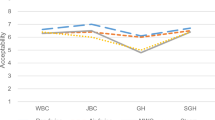Abstract
A sensory evaluation test with 320 subjects provided information pertinent to the preference of peanut butters. Results of paired preference test indicated that more than half the subjects (59%) preferred the “old fashioned” sample; flavor (aroma and taste) would have to be the primary reason since particle size was nearly the same in the prepared test samples. Chi-square tests of independence showed that the preference for the “old fashioned” sample was dependent on age (P<.05) and sensory attributes of flavor and textural perception (P<.05). Results of the survey showed that 47% of the total responding subjects listed “crunchy” peanut butter as their favorite type. Selection of one’s favorite brand of commercial peanut butter was found to be based primarily on its particle size.
Similar content being viewed by others
References
Anon., USDA Puts Peanuts in Perspective. Peanut Journal and Nut World, Vol. LXII (4):20 (1983a).
Woodroof, J.G., “Peanuts: Production, Processing, and Products,” 3rd Ed., Avi Pub. Co., Westport, CT (1983).
Anon., Peanuts, in “Foods and Nutrition Encyclopedia,” Vol. 2, p. 1726. Ensminger, A.H., et al., eds. Pegus Press, Clovis, CA (1983b).
Anon., Code of Federal Regulations, 12 CFR 164.140, Office of the Federal Register, Washington, DC (1981).
Syarief, H., Statistical Evaluation of Flavor and Texture Profile Methods for Describing Food Products. Ph.D. Thesis, North Carolina State Univ., Raleigh, NC (1983).
Thomas Register, Thomas Publishing, New York, NY (1973).
Desor, J.A., L.S. Greene and O. Maller, Preference for Sweet in Humans: Infants, Children and Adults. “Taste development.” D.H.E.W. Pub. No. (NIH): 77-1068. U.S. Dept. of Health, Education and Welfare, Nat. Inst. of Dental Health (1977).
Thomas, M.A., and F.S. Murray, Taste Perception in Young Children. Food Technol. 34(3):38 (1980).
Larmond, E., Laboratory Methods for Sensory Evaluation of Food, Pub. 1637, Research Branch, Canada Dept. of Agric. (1982).
SAS, “User Guide.” SAS Institute, Cary, NC (1982).
Steel, R.G.D., and J.H. Torrie, “Principles and Procedures of Statistics,” 2nd Ed. McGraw-Hill Book Co., New York (1980).
Taylor, D.L., Analysis of new food products. Food Enign. 54 (10):75 (1982).
Author information
Authors and Affiliations
About this article
Cite this article
How, J.S.L., Young, C.T. Factors affecting peanut butter preference. J Am Oil Chem Soc 62, 538–540 (1985). https://doi.org/10.1007/BF02542328
Received:
Issue Date:
DOI: https://doi.org/10.1007/BF02542328




